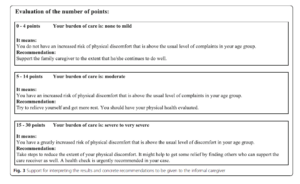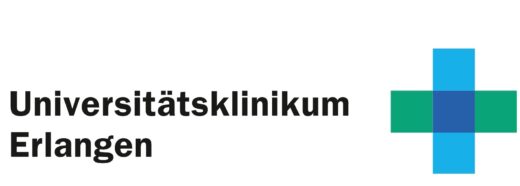
The “Burden Scale for Family Caregivers – short version” (BSFC-s) is another instrument for measuring caregivers’ (CG) subjective burden in the home environment. It was developed from the long version, which was validated by Gräßel (2001).

The BSFC-s is a self-assessment scale with 10 statements about CGs’ subjective burden. For each statement, the degree of agreement is determined on a 4-point scale (strongly agree, agree, disagree, strongly disagree). The sum score ranges from 0 to 30 points, with a higher score indicating a greater subjective burden.
The BSFC-s sum score is assigned to the following categories, the threshold values of which were determined empirically (Pendergrass et al., 2018): no increased risk of physical complaints and depression (0-4 points), increased risk of physical complaints but no increased risk of depression (5-14 points), and greatly increased risk of physical complaints and increased to greatly increased risk of depression (15-30 points).
The BSFC-s can be used in both research and practice. The German version was extensively scientifically validated in 2014 and 2018.
If the BSFC-s is used noncommercially, the scale can be downloaded without license fees (free of charge). It is available in the following languages: Arabic, Croatian, Czech, Dutch, English, Finnish, French, German, Greek, Hindi, Hungarian, Italian, Japanese, Korean, Norwegian, Malay, Polish, Portuguese, Romanian, Russian, Spanish, Swedish, Turkish, Ukrainian, and Urdu. You can register here to download the BSFC-s free of charge.
CGs have an increased risk of developing psychological complaints, especially depression (e.g., del-Pino-Casado et al., 2019 and del-Pino-Casado et al., 2021) and physical complaints, (e.g., cardiovascular diseases; Ahn et al., 2022). Another risk factor is abusive behavior towards the care-recipients (Boye & Jan, 2018), including aggressive behavior (Grafström et al., 1993; Storey, 2020). There are CGs to whom none of these risks apply. However, there is a scientifically proven correlation between these risks and the subjective burden of the CG: the greater the subjective burden of the CG, the more pronounced the health (Gräßel, 1998) and behavioral risks (Boye & Jan, 2018). It is therefore important to identify “at-risk relatives” (i.e., those with high levels of stress). Measures can then be introduced to reduce the burden and thus the risk of negative effects. The BSFC-s was developed as a valid screening instrument to record the subjective burden of the CG. Repeat surveys can be used to assess the effectiveness of interventions and support measures.
The BSFC-s can be completed by all carers, regardless of the cause of the need for care (e.g., stroke, cancer, rheumatism, dementia), and also regardless of the relationship between the CG and the person being cared for (caring parent, caring partner, caring adult children, no degree of kinship in the case of relatives).
The BSFC-s was developed and validated for CGs, regardless of the cause of the need for care (e.g., stroke, cancer, rheumatism, dementia), regardless of the relationship of the CGs to the care-recipients (caregiving parent, caregiving partner, caregiving adult children, no degree of kinship with relatives), and also regardless of the intensity of the need for help (from light support to severe need for care). The BSFC-s can also be used regardless of the severity of the need for assistance, from the initial need for support to the need for round the clock care. The prerequisite is that the CGs must be informal CGs. The burden on professional CGs can be validly recorded using another instrument: the Professional Care Team Burden (PCTB) scale (Auer et al., 2015).
The BSFC-s (10 items) was developed from the long version of the BSFC (28 items). As the situation in caring for dementia patients contains additional stress factors compared with caring for people who do not suffer from dementia, the BSFC results in differences in the degree of stress experienced by CGs (Gräßel, 1998). It can be assumed that these differences are also reflected in the BSFC-s.
Given that the BSFC-s is available in different languages, it is also suitable for cross-cultural comparisons of the subjective burden of CGs. Here, you can find a comprehensive overview of the current use of the BSFC-s in research worldwide.
The risk of unfavorable effects of home care on the health of CGs is strongly dependent on the degree of subjective burden. With low subjective burden, there is no increased risk of unfavorable health effects (values in the “green” range). When subjective burden is moderate, the risk to health increases (“yellow” range). When subjective burden is high, the risk to health is much higher (“red” range). CGs can assess themselves on the Internet using a digitalized form of the BSFC-s. Click here to go directly to the digital BSFC-s.
The evaluation and interpretation are carried out in three steps:
(1) Point value per item: Each item in the HPS-k is rated on a four-point scale:
| Answer | Points |
| strongly agree | 3 |
| agree | 2 |
| disagree | 1 |
| strongly disagree | 0 |
(2) Calculation of the total value from the point values of all 10 items.
(3) Interpretation of the total value: The higher the total score, the more pronounced the subjective burden. Furthermore, the total score can be interpreted using the following table (Pendergrass et al., 2018):

Here you can download information on the evaluation and interpretation of the BSFC-s.
Here you can download information about how to deal with missing values.
Auer, S., Graessel, E., Viereckl, C., Kienberger, U., Span, E. & Luttenberger, K. (2015). Professional Care Team Burden (PCTB) scale – reliability, validity and factor analysis. Health and Quality of Life Outcomes 13(17). DOI: 10.1186/s12955-014-0199-8. (Open access)
Boye, F. & Yan, E. (2018). Abuse of older persons with dementia: A review of the literature. Trauma, Violence & Abuse 19(2), 127-147.
Grafström, M., Nordberg, A. & Winblad, B. (1993). Abuse is in the eye of the beholder: Reports by family members about abuse of demented persons in home care A total population-based study. Scandinavian Journal of Social Medicine, 21(4), 247-255.
Gräßel, E. (1998). Häusliche Pflege dementiell und nicht dementiell Erkrankter Teil II: Gesundheit und Belastung der Pflegenden. Zeitschrift für Gerontologie und Geriatrie, 31, 57-62.
Gräßel, E. (2001). Häusliche-Pflege-Skala HPS zur Erfassung der Belastung bei betreuenden oder pflegenden Personen. Ebersberg: Vless.
Gräßel, E., Berth, H., Lichte, T. & Grau, H. (2014). Subjective caregiver burden: validity of the 10-item short version of the Burden Scale for Family Caregivers BSFC-s. BMC Geriatrics, 14, 1-9. (Open access)
Pendergrass, A., Malnis, C., Graf, U., Engel, S. & Graessel, E. (2018). Screening for caregivers at risk: Extended validation of the short version of the Burden Scale for Family Caregivers (BSFC-s) with a valid classification system for caregivers caring for an older person at home. BMC Health Services Research, 18, 1-9. (Open access)
Storey, J. E. (2020). Risk factors for elder abuse and neglect: A review of the literature. Aggression and Violent Behavior, 50, 101339.
You can register to download the scales here.
! Those responsible for this website guarantee that all information provided during registration will be treated confidentially, in particular that it will not be passed on to third parties.
Downloading is permitted for non-commercial use only, which means specifically that
- the respondent completing the self-assessment tool incurs no immediate (direct) costs (billing as a health insurance benefit by third parties, e.g., doctors, is possible) and
- the BSFC-s is not resold to third parties in any form as part of a combined survey tool consisting of several survey instruments (e.g., as part of a larger, fee-based assessment tool).
Burden Scale for Family Caregivers (BSFC); Burden Scale for Family Caregivers – short form (BSFC-s); Informal Caregiver (CG); Arithmetic mean (M); Standard deviation (SD)
